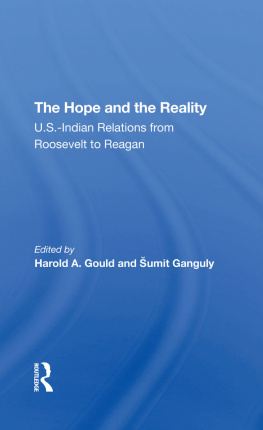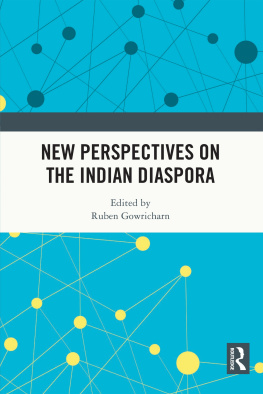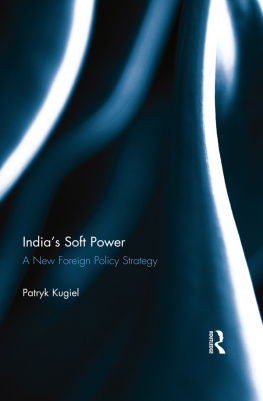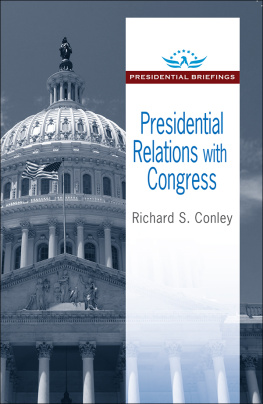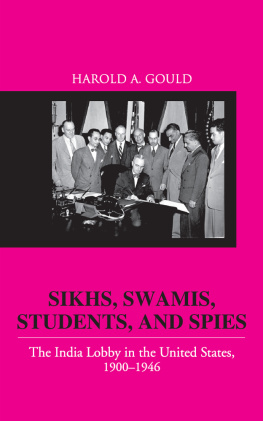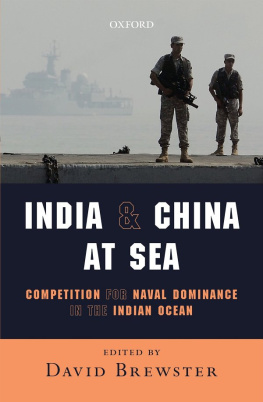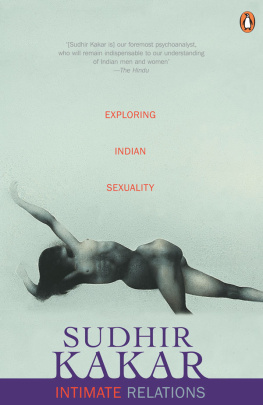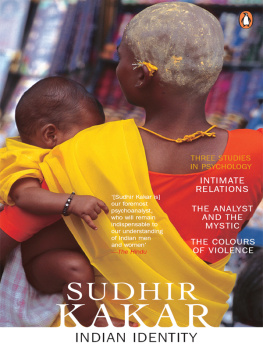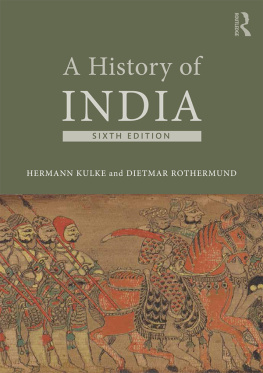First published 1992 by Westview Press, Inc.
Published 2019 by Routledge
52 Vanderbilt Avenue, New York, NY 10017
2 Park Square, Milton Park, Abingdon, Oxon OX14 4RN
Routledge is an imprint of the Taylor & Francis Group, an informa business
Copyright 1992 Taylor & Francis
All rights reserved. No part of this book may be reprinted or reproduced or utilised in any form or by any electronic, mechanical, or other means, now known or hereafter invented, including photocopying and recording, or in any information storage or retrieval system, without permission in writing from the publishers.
Notice:
Product or corporate names may be trademarks or registered trademarks, and are used only for identification and explanation without intent to infringe.
Library of Congress Cataloging-in-Publication Data
The Hope and the reality : U.S.-Indian relations from Roosevelt to Reagan / edited by Harold A. Gould and Sumit Ganguly.
p. cm.
Includes bibliographical references and index.
ISBN 0-8133-8383-8
1. United StatesForeign relationsIndia. 2. IndiaForeign relationsUnited States. I. Gould, Harold A. (Harold Alton), 1926 - . II. Ganguly, Sumit.
E183.8.14H64 1992
327.73054'09'04dc20
91-45051
CIP
ISBN 13: 978-0-367-29286-7 (hbk)
1
Introduction: The Strained Relationship
Harold A. Gould and umit Ganguly
The chapters in this volume represent a variety of perspectives on U.S.-Indian relations. The editors deliberately refrained from asking the contributors to adhere to a preconceived framework. We felt that the authors, all experienced scholars and professionals in the foreign policy field, should be free to analyze their chosen topic according to their own light. The final drafts convinced us that we made the correct decision. It is our shared belief that the detailed, unsentimental treatment presented here of the forces that have driven U.S.-Indian relations over the past four decades will enable policymakers on both sides to better understand the possibilities as well as the limits of this relationship.
If there is a dominant theme that runs through all of the chapters it is that relations between the United States and India have been far from idyllic. Yet they have not been devoid of much that is positive. The authors of the various contributions assembled here have laid stress on the reasons, from their temporal, professional, and ideological vantages, this mixed pattern seems to have been the case regardless of which administration was in power in Washington. The relationship between the United States and India has reflected a curious pattern of interaction in many ways, because at the time of Indian independence, shortly after the end of World War II, expectations of a very different order ran so high. These high expectations arose from the fact that India seemed destined to emerge as the world's largest, and Asia's first, fully democratic state. For this reason it was widely believed that a natural affinity would exist between India and the United States, by far the world's most celebrated democracy, in the domain of international politics. However, relations between the United States and India never achieved the degree of harmony and unanimity that many in both countries anticipated.
Many factors played roles in determining the actual course of U.S.-Indian relations. But all of the studies presented here show in one way or another that two factors stood out above all others from the very beginning. One was the preoccupation of the United States, as leader of the Western group of states that coalesced after the shooting stopped in Europe and Asia, with containing what was perceived to be Soviet expansionism. This preoccupation led to the Cold War and the accompanying policies toward the South Asian region that severely exacerbated U.S.-Indian relations. That these policies had such an effect was partly attributable to the second factor, which was India's preoccupation under the leadership of Jawaharlal Nehru with a policy that fundamentally rejected the premises of the Cold War by creating a coalition of so-called nonaligned states that resisted incorporation into either the American-led or the Soviet-led bloc.
This policy of nonalignment appears to have bothered the United States much more than it did the Soviet Union. The Soviets adjusted to it fairly rapidly and began to capitalize on America's peevish reluctance to do so. Jane Wilson, in her chapter on the Kennedy period (), points out that this adaptability enabled the Soviet Union's much more modest foreign aid to India to have a political impact far out of proportion to its magnitude. The American attitude stemmed from a sense of betrayal over Jawaharlal Nehru's unwillingness to declare India a capitalist society and decisively commit India to the Western bloc of nationsand indeed to take the lead in trying to induce others to follow India in this regard.
Evidence suggests that U.S. disillusionment and frustration arose from initial Western perceptions of Nehru as an almost archetypal by-product of the Westminister tradition who would most certainly identify himself with the Western value system, reject Stalinist totalitarianism, and join the crusade against the spread of communism. This "misreading" of Jawaharlal Nehru is extensively discussed by Harold A. Gould in . It proved to be highly important to realize that Nehru's affection for parliamentary democracy was qualified by a lingering hatred of Western colonialism, a deep aversion to fascism (which he equated with colonialism), a profound commitment to socialism, and considerable admiration for the Soviet Union's success in rapidly industrializing itself under the rubric of Marxism-Leninism.
As . M. Jain has expressed it, "Post-war US diplomacy was mainly directed to fighting what US policy-makers referred to as 'militant monolithic communism.'" He continued:
Despite a resulting persistent undercurrent of mutual annoyance in relations between the United States and India, however, the relationship between the two countries was never uniformly unfriendly, nor, of course, did it ever (with one fairly mild exception) lead to anything close to military confrontation. As Arthur G. Rubinoff points out in , the record is one of rather wide swings that usually depended on what was taking place in the larger compass of the Cold War.
The Referents of U.S.-Indian Relations
When one looks retrospectively at the patterns of interaction that have transpired between the United States and India, one is struck by how diverse have been the events that have marked the important upward or downward shifts in the quality of their relations. The first milestone, of course, was the Kashmir War of 1947, which erupted almost before the ink on the partition documents was dry. In many respects, this eruption of hostilities between the newly created nations of India and Pakistan established the framework of regional antipathy into which the great power rivalry that was beginning to dominate the postwar world could intrude. For with India and Pakistanthe two national culminations of the long and bitter separatist struggle between Hindus and Muslims in the subcontinentimplacably at odds over the volatile issue of such a strategically situated region as Kashmir, conditions were ideal for outside powers to exploit the situation for larger purposes. Opportunities to do so became especially ripe once it was perceived that India and Pakistan were prepared, for whatever mix of political motives, to adopt opposing attitudes toward the emerging Cold War.

